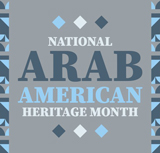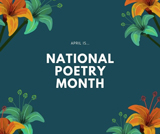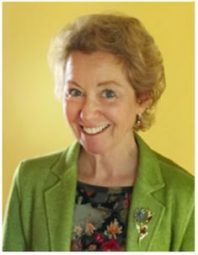
Clare Meeker
Clare Meeker is a passionate researcher with a love for telling stories to children. She was the perfect local candidate to be the special guest at The Society of Children’s Book Writers and Illustrators meeting the last Sunday of September for their nonfiction craft talk.
I realized that throughout my various interviews with authors, I have never interviewed a children’s writer! With Clare Meeker’s upcoming appearance at our store, I thought this a great opportunity to check this off my Blog Bucket List. What’s most interesting about Clare is that she is also a researcher, not to mention a longtime friend of the store. The stories that she tells take a great amount of work and knowledge that has to be distilled and translated to an elementary school-aged kid. Most of her books focus on Pacific Northwest Animals, and her newest release, Growing Up Gorilla is about a gorilla family from the Woodland Park Zoo. I thought I would ask her how she decided to bring these two ideas together…
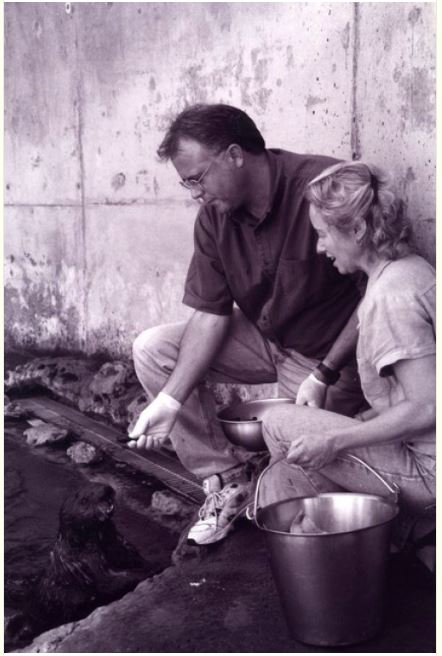
Clare watching Casson feed Lootas
Island Books: What brought you to bring real animal stories to children?
Clare Meeker: Kids love reading real animal stories because they can share what they learn and show what they know about the animals they are most interested in. My first true animal story, Lootas, Little Wave Eater, was about an orphaned sea otter who was born in the wild but lost her mother at one month of age. Lootas was rescued and hand-raised at the Seattle Aquarium by their marine mammal curator C.J. Casson who allowed me to follow his progress caring for her for six months until she was old enough to be adopted by an adult female sea otter. Watching the amazing dedication of these animal care specialists who give their days and nights to helping these animals survive and thrive was inspiring. From then on, I was hooked! By the way, Lootas is 23 years old this year and a grandmother several times over, as I am about to be.
IB:How sweet! Congratulations! How was writing this book different from your other nonfiction animal narratives? What brought you to this story?
CM: What was different about writing this book was having to write a draft of the story and secure a publisher before I could interview the gorilla keepers and write the final book. The most likely reason for this was that the Woodland Park Zoo administration wanted to be sure that that there would be a concrete product that would justify giving the keepers time away from their work with the gorillas to talk with me. They probably get many requests from people saying they want to write books about their animals and they wanted to make sure I was serious. It took three and half years to research, write, and publish Growing Up Gorilla, but persistence is the most important part of making a career of writing.
I had had thought about doing a book many years ago about Yola’s mother, Nadiri, when she was a young and her mother had rejected her after a difficult birth. When an article appeared in the Seattle Times in 2015 about the 19-year old Nadiri at the Woodland Park Zoo giving birth for the first time and walking away from her baby, I knew there was a bigger story to tell about life in a gorilla family at the zoo and what it takes to build a bond between a mother and daughter.
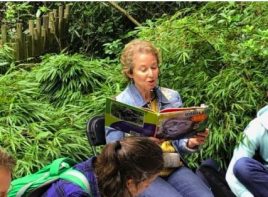
Clare at Woodland Park Zoo for the Growing Up Gorilla book launch
IB: Did you get to interact with the gorillas or was the story only told to you secondhand through the keepers?
CM: Though I never was able to interact with the gorillas directly, I spent many hours watching Nadiri and Yola’s family group in the zoo’s outdoor exhibit learning about their different personalities and how they interacted socially or not. It is amazing to see how curious and engaging the gorillas can be with the public and to feel their steady gaze right through the glass that separates us. The story is about how baby Yola and her mother Nadiri were able to bond over time thanks to the patient determination of the keepers and with help from the shy silverback male, Leo, who showed an interest in the baby from the start. Only the keepers and the infant animal care specialist were allowed behind the scenes in the gorilla house, but even they could not enter a den when there was a gorilla inside it, except to care for Yola in her own den during the first few months.
IB:What did the research process look like? What was your favorite part of the research process?
CM:I love the research part of creating a nonfiction book. The internet has certainly made it easier to get the basic facts about a particular animal or the life of a famous person in history. But the most exciting and reliable research is when you can look at primary documents – for example, Abigail Adams’ handwritten journals for a biography I wrote for children or the gorilla keeper’s record book which described daily observations of Yola’s development and the big and small breakthroughs in the mother/daughter bonding process. I also read books and essays by people who have personally studied gorilla’s in the wild, including George B. Schaller’s groundbreaking book, The Mountain Gorilla, published in 1963, and Dian Fossey’s fascinating 1983 book, Gorillas in the Mist, about her long term field study of mountain gorillas that ended with her mysterious death thought to be by poachers. But when it comes to writing narrative nonfiction, the facts I’ve learned must be in service or woven into the story I want to tell. My true animal stories start with a problem that has to be solved and have a tension and dramatic build to a climax like any good story. That is the craft of writing.
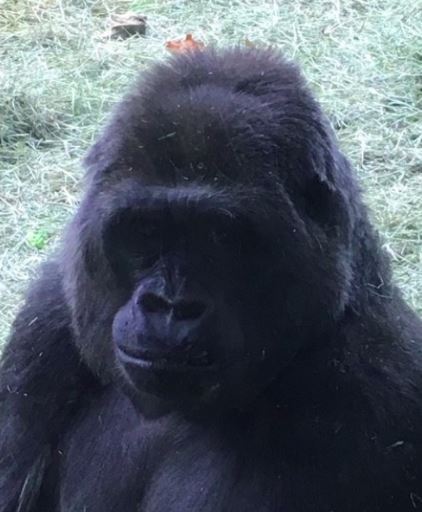
Akenji, Yola’s auntie, looking at Clare through the exhibit glass
IB: What are you working on next?
CM:I have submitted a new manuscript to my publisher about co-raising a Labrador retriever who became a service dog and life-time companion to a man who’d lost use of his legs. I also have an idea for a middle grade historical fiction novel. It would be quite a challenge for me both in word count and character development, but I’m already fired up by the research I’ve done so far.
IB:Well we will certainly look forward to hearing news about these pieces! Thank you so much, Clare!
—Kelleen, Island Books, Mercer Island, WA
This was orginally posted to the Island Books tumblr.


